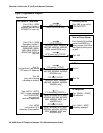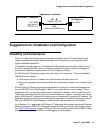
Overview of Voice over IP (VoIP) and Network Protocols
26 4600 Series IP Telephone Release 2.2 LAN Administrator Guide
You can restrict which IP Addresses the telephone accepts SNMP queries from. You can also
customize your community string with system values SNMPADD and SNMPSTAT, respectively,
as indicated in Chapter 4: Server Administration
, Table 6: 4600 Series IP Telephone
Customizable System Parameters.
To find more information about SNMP and MIBs, see the IETF references listed in Related
Documents on page 15. The Avaya Custom MIB for the 4600 Series IP Telephones is available
for download in *.txt format on the Avaya support Web site.
Network Assessment
The current technology allows optimum network configurations to deliver VoIP with perceived
voice quality close to that of the Public Switched Telephone Network (PSTN). Not all networks
can take advantage of packet voice transmissions. Some data networks have insufficient
residual capacity for even compressed voice traffic. In addition, the usual approach to
developing data networks by integrating products from many vendors requires testing the
components for Voice over IP traffic compatibility.
Avaya assumes that your organization has performed a network assessment with or without
Avaya’s assistance before attempting to install Voice over IP. The network assessment provides
a high degree of confidence that the existing data network has the capacity to carry voice
packet traffic. The network assessment assures that the existing data network is compatible
with the required technology.
A network assessment should include:
● A network audit to review existing equipment and evaluate its capabilities, including its
ability to meet planned voice and data needs.
● A determination of network objectives, including the dominant traffic type, selection of
technologies, and setting voice quality objectives.
The assessment should leave you confident that the implemented network will have the
capacity for the foreseen data and voice traffic, and can support H.323, DHCP, TFTP, and jitter
buffers in H.323 applications.
It is important to distinguish between compliance with the minimal VoIP standards and QoS
support, the latter being a requirement to run VoIP on your configuration.


















